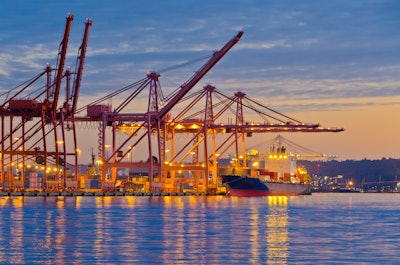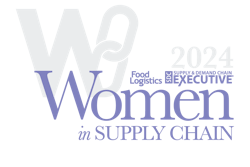
In September, U.S. ports spanning Maine to Texas shut down after the International Longshoremen’s Association, a union representing 45,000 dockworkers, went on strike for the first time since 1977. The situation sparked panic about the potential ripple effects of widespread port closures on the U.S. supply chain. The 14 largest ports affected by the strike handled 25% of U.S. goods imports and 27% of exports, worth 2.8% and 1.9% of America’s GDP, respectively, according to Goldman Sachs.
A prolonged shutdown could have caused major CPG shortages and price increases not seen since the COVID-era, costing the U.S. economy $4.5 billion per day and shaving half a percentage point off the U.S. GDP for the fourth quarter. It would have impacted everything from bananas, European beer, wine and liquor to furniture, clothing, household goods and European autos, as well as parts needed to keep U.S. factories operating and American workers in those plants on the job. It also could have stopped U.S. exports that flow through those ports, hurting sales for American companies.
On Oct. 4, both parties agreed to suspend the strike to Jan. 15, 2025 and temporarily reopen the ports while they continue negotiations. The situation was a stark reminder of the continually volatile environment CPG organizations (CPGs) are operating in today – underscoring the importance of having well-defined strategies in place that build systematic resilience to unanticipated supply chain shocks. While CPGs may have dodged a bullet that time around, it’s not a matter of “if” another major disruption will occur – it’s when.
Hurricane Milton was a prime example. Later in October, the fourth hurricane to strike Florida agriculture in 14 months caused severe damage to two-thirds of the state’s citrus belt, which will likely lead to production shortages and price hikes for oranges, grapefruits, and other commodity fruits. This comes at a time when CPGs are already navigating a wide range of commodity-related challenges. McKinsey forecasts estimate that commodity prices are expected to remain elevated, at 20–40% above 2019 levels, until at least 2025. With uncertainty a constant, it is important to consider the consequences associated with lack of preparedness. For example, at the height of the Covid-19 pandemic, CPGs with supply chain disruptions experienced significant revenue hits amid widespread out-of-stocks. As U.S. consumers increasingly switched brands in favor of product availability, a Wall Street Journal report found that CPGs with low on-shelf availability or in-stock rates of between 72% and 85% lost 0.7 percentage points of share of wallet in 2022. According to NielsenIQ data, these pandemic-related out-of-socks caused nearly $3 billion in lost sales across 10 CPG categories.
In addition to Covid-19, the ripple effects of geopolitical tensions, extreme weather, inflationary pressures, raw material shortages, labor challenges and human migration patterns away from the equator have all strained CPG supply chains in some form or fashion. Compounded at scale, they cost global businesses an estimated $1.6 trillion annually in missed revenue opportunities over the course of 2021 and 2022.
Considering hindsight is 20/20, lessons learned from the past should be applied to shape future strategies. The ramifications of reactionary supply chain management approaches showcase why CPGs must develop systematic resiliency that enables them to navigate disruption from a position of strength. While CPG leaders can’t control their external circumstances, what can always be controlled is how they respond to them.
The Vital Role of Contingency Planning
Effective contingency planning is worth its weight in gold for managing uncertainty. The ability to pivot swiftly and decisively has become a critical differentiator for leading CPG brands. A 2024 Accenture study found that companies in the top quarter of its resiliency maturity scale captured 3.6% greater revenue than industry peers in the bottom quarter. Further, the competitive advantage it established helped the top quartile achieve an additional 1.2 percentage points in EBIT margin compared to lower-resilience competitors.
By developing off-the-shelf contingency plans and adaptable response frameworks in advance, CPGs can dramatically reduce reaction times and minimize the risk of unforeseen events on their operations, market position, and bottom line. In addition, it enables them to seize opportunities that arise amid chaos, potentially turning disruptive events into catalysts for innovation and growth. This further instills confidence amongst cross-functional stakeholders, from employees and suppliers to investors and customers, by reinforcing the company's image as a reliable partner capable of weathering any storm.
Shaping Demand with Scenario-Based Modeling
CPG contingency plans must be designed around the integrated adoption of AI-enabled technologies that provide the means for systematically modeling how to adjust to supply chain events in a way to outpaces competition. McKinsey estimates that autonomous supply chain planning can increase revenue by up to 4%, reduce inventory by up to 20%, and lower supply chain costs by up to 10%. This is largely why nearly half of survey respondents in a recent IDC Info Snapshot cited by Forbes said they planned to increase the use of technology for supply chain management, ranking the strategy higher than supplier diversification (41%), financial hedging for price stability (38%), and locking in long-term contracts (38%).
Leveraging advanced analytics and automated decision-making systems allows CPGs to conduct predictive, scenario-based modeling relative to the degree of probability that certain events will unfold, further enabling them to optimize, restructure, and rebalance their portfolios for foundational resilience to disruption. Based on prescriptive insights generated by the modeling, they can then incorporate strategic supply sourcing, pricing, and trade promotional strategies that shape demand by incentivizing consumers to pivot away from impacted items in favor of alternative products. If models indicate a supply chain event will cut off supply to bananas, a food manufacturer could quickly implement promotional strategies that reduced demand for banana yogurt and increased demand for vanilla yogurt, which has a similar flavor profile that appeals to most consumers who typically prefer banana-type products. With scenario-based modeling as its guide, the manufacturer is far better positioned to maintain sales, revenue and brand loyalty in the wake of an ongoing shortage.
Building Workforce Capability
Across any industry, the impact of technology adoption is fundamentally reliant on an organization’s ability to utilize it. Nearly 40% of midsize CPGs surveyed in the IDC Info Snapshot were concerned that a lack of digital competencies limited their ability to adapt to and adopt new business models. As technology adoption progresses, CPGs must prioritize developing their human capital to fully capitalize on predictive modeling and scenario planning.
This involves a multi-faceted approach that extends beyond traditional training programs. First, organizations should focus on fostering a culture of continuous learning by cultivating an environment where employees are encouraged to stay current with emerging technologies and industry trends. Continual workshops, seminars, and cross-functional training sessions can help build a workforce that is not only skilled in their specific roles but also has a broader understanding of how digitalization impacts the entire supply chain ecosystem. Secondly, CPGs should focus on developing analytical and critical thinking skills across all levels of the organization.
As predictive models become more sophisticated, employees must be able to interpret complex data, identify patterns, and make informed decisions based on various scenarios. Positioning them to leverage supply chain digitalization as an augmentation tool could also catalyze the creation of new high-quality job opportunities designed around the facilitation and maintenance of AI-enabled technologies. In addition, the development of soft skills such as communication, collaboration, and leadership should also be a priority for CPG leaders. During times of crisis or rapid change, these skills become crucial for effectively implementing contingency plans and coordinating across departments and with external partners. By investing in their workforce's capabilities, CPGs can create a human-technology synergy that not only responds effectively to supply chain disruptions but also drives innovation and competitive advantage in an increasingly volatile landscape.



![Pros To Know 2026 [color]](https://img.sdcexec.com/mindful/acbm/workspaces/default/uploads/2025/08/prostoknow-2026-color.mduFvhpgMk.png?auto=format%2Ccompress&bg=fff&fill-color=fff&fit=fill&h=100&q=70&w=100)







![Pros To Know 2026 [color]](https://img.sdcexec.com/mindful/acbm/workspaces/default/uploads/2025/08/prostoknow-2026-color.mduFvhpgMk.png?ar=16%3A9&auto=format%2Ccompress&bg=fff&fill-color=fff&fit=fill&h=135&q=70&w=240)




